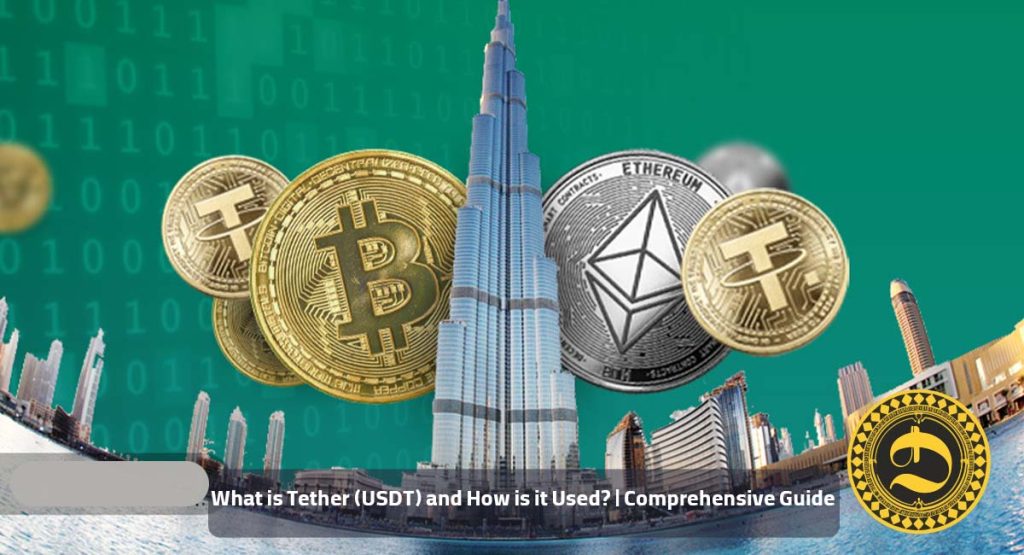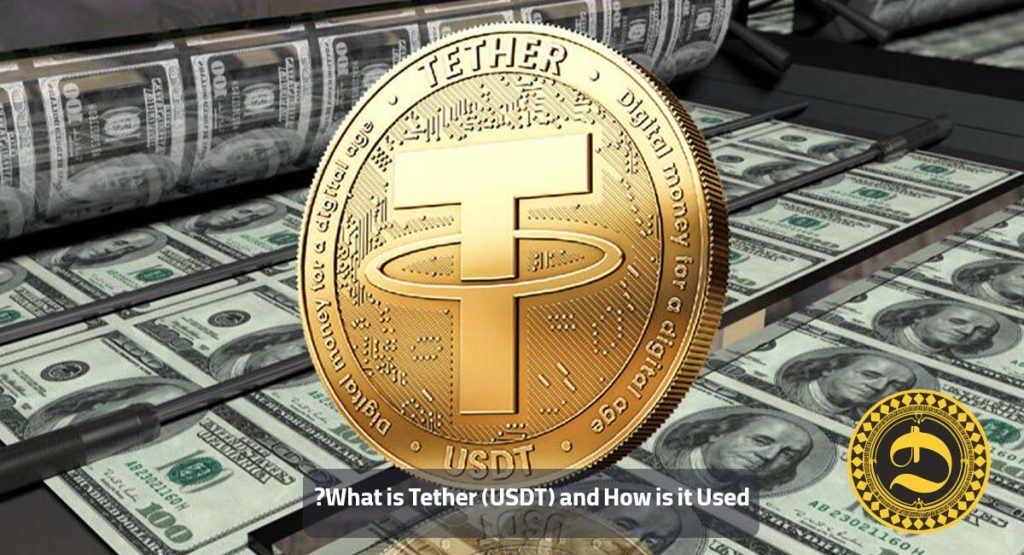Introduction to Cryptocurrencies (USDT)
What is Tether (USDT) and How is it Used? Cryptocurrencies are digital or virtual currencies that use cryptography for security. They operate independently of a central authority, such as a bank or government. The most well-known cryptocurrency is Bitcoin, which was introduced in 2009. Since then, thousands of alternative cryptocurrencies, often referred to as altcoins, have been created. Cryptocurrencies are built on blockchain technology, which is a decentralized ledger that records all transactions across a network of computers.
Table of Contents
What is Tether (USDT) and How is it Used?
Tether (USDT) is one of the most widely used stablecoins in the cryptocurrency market. Launched in 2014, Tether aims to bridge the gap between fiat currencies and cryptocurrencies by providing a stable digital currency that can be easily exchanged between different exchanges and platforms. Each Tether token is pegged 1-to-1 with a matching fiat currency (e.g., 1 USDT = 1 USD), and is backed by Tether’s reserves. This pegging mechanism ensures that the value of USDT remains relatively stable, providing a reliable means of transferring value and conducting transactions within the cryptocurrency ecosystem.
What is Tether (USDT)?

Definition of Tether
- Tether (USDT) is a type of cryptocurrency known as a stablecoin. Stablecoins are digital currencies designed to maintain a stable value by being pegged to a reserve asset, often a fiat currency like the US Dollar (USD).
- USDT is pegged to the USD at a 1:1 ratio, meaning 1 USDT is intended to always equal 1 USD.
History and Creation
- Tether was initially launched as Realcoin in July 2014 by Brock Pierce, Reeve Collins, and Craig Sellars.
- In November 2014, the project was rebranded to Tether.
- The idea behind Tether was to create a stable cryptocurrency that could bridge the gap between fiat currencies and blockchain assets, offering stability, transparency, and minimal transaction charges.
Founders and Key Players
Stuart Hoegner: General Counsel for Tether and Bitfinex, playing a crucial role in legal and regulatory affairs.
Brock Pierce: A well-known entrepreneur in the cryptocurrency and entertainment industries. He is a co-founder of Tether and has been involved in several other high-profile blockchain projects.
Reeve Collins: Co-founder and former CEO of Tether. Collins has a background in marketing and technology startups.
Craig Sellars: Chief Technology Officer (CTO) of the Mastercoin Foundation, which later evolved into the Omni Layer, the protocol on which Tether was initially built.
Jan Ludovicus van der Velde: Current CEO of Bitfinex and Tether.
How Does Tether Work?
Mechanism of Tether
- Tether operates as a stablecoin, meaning its value is pegged to a stable asset, typically the US Dollar.
- Tether Ltd., the company behind USDT, claims to hold reserves equivalent to the amount of USDT in circulation. This reserve is intended to back each USDT token 1:1 with USD or equivalent assets.
- When a user purchases USDT, they are essentially exchanging fiat currency for an equivalent amount of Tether tokens. Conversely, when a user redeems USDT for fiat currency, the tokens are taken out of circulation.
How It Maintains Its Peg to the US Dollar
- Reserves: Tether maintains a reserve of assets, which includes cash, cash equivalents, and other assets. These reserves are meant to ensure that each USDT token can be redeemed for one US Dollar.
- Transparency Reports: Tether periodically releases transparency reports that detail the reserves backing USDT, although the completeness and accuracy of these reports have been subject to scrutiny and controversy.
- Market Mechanisms: In practice, the peg is maintained through market mechanisms on various exchanges. If the price of USDT deviates from $1, arbitrage traders buy or sell USDT until it returns to its pegged value.
Blockchain Technology Behind Tether
- Omni Layer: Tether was originally issued on the Bitcoin blockchain via the Omni Layer protocol, which is a platform for creating and trading custom digital assets and currencies.
- Ethereum: Tether expanded to the Ethereum blockchain as an ERC-20 token, which is a popular standard for creating tokens on the Ethereum network. This increased Tether’s interoperability with various decentralized applications (dApps) and exchanges.
- Tron: Tether is also available on the Tron blockchain as a TRC-20 token. Tron offers faster transaction times and lower fees compared to Ethereum.
- Other Blockchains: Tether has been integrated into other blockchains as well, such as EOS, Algorand, and Solana, to enhance liquidity and accessibility across different platforms.
Each blockchain version of Tether operates under the same fundamental principle of being pegged to the US Dollar, but they offer different features and benefits in terms of transaction speed, fees, and network compatibility.

Types of Tether Tokens
USDT on Different Blockchains
- Omni Layer (Bitcoin Blockchain): The original Tether token issued on the Bitcoin blockchain via the Omni Layer protocol.
- Ethereum (ERC-20): Tether issued as an ERC-20 token on the Ethereum blockchain.
- Tron (TRC-20): Tether issued as a TRC-20 token on the Tron blockchain.
- EOS: Tether issued on the EOS blockchain.
- Algorand: Tether issued on the Algorand blockchain.
- Solana: Tether issued on the Solana blockchain.
- Other Blockchains: Tether has also been issued on blockchains like Binance Smart Chain and Liquid.
Comparison Between Various Tether Tokens
| Blockchain | Token Standard | Transaction Speed | Transaction Fees | Network Compatibility | Main Use Cases |
|---|---|---|---|---|---|
| Omni Layer | Omni | Slow | High | Bitcoin | Original issuance, legacy use |
| Ethereum | ERC-20 | Moderate | High | Ethereum | DeFi, dApps, wide adoption |
| Tron | TRC-20 | Fast | Low | Tron | Low-cost transactions, high volume transfers |
| EOS | EOSIO | Fast | Low | EOS | High throughput applications |
| Algorand | ASA | Very Fast | Very Low | Algorand | Instant finality, high scalability |
| Solana | SPL | Very Fast | Very Low | Solana | Low latency, high performance DeFi applications |
Advantages and Disadvantages of Each Type
- Omni Layer (Bitcoin Blockchain):
- Advantages: Secure and robust due to Bitcoin’s network; original and widely recognized.
- Disadvantages: Slow transaction speeds; high fees; less efficient for high-frequency trading.
- Ethereum (ERC-20):
- Advantages: Wide adoption; integrated with numerous DeFi platforms and dApps; large developer community.
- Disadvantages: Higher transaction fees; network congestion can cause delays; scaling issues.
- Tron (TRC-20):
- Advantages: Fast transaction speeds; low fees; suitable for high-frequency and microtransactions.
- Disadvantages: Smaller developer community; less decentralized than Ethereum; less mature ecosystem.
- EOS:
- Advantages: Fast transaction speeds; low fees; suitable for applications requiring high throughput.
- Disadvantages: Centralization concerns; smaller ecosystem compared to Ethereum.
- Algorand:
- Advantages: Very fast transaction finality; very low fees; highly scalable; robust security.
- Disadvantages: Smaller ecosystem; newer technology with less adoption compared to Ethereum.
- Solana:
- Advantages: Very high performance; low latency; very low fees; increasing adoption in DeFi.
- Disadvantages: Relatively new and still maturing; occasional network stability issues.
Each type of Tether token offers unique advantages and is suited for different use cases. Users can choose the version that best fits their needs based on factors like transaction speed, fees, and compatibility with other blockchain applications.

Uses of Tether (USDT)
Trading and Investments
- Stable Trading Pair: USDT is widely used as a stable trading pair on cryptocurrency exchanges, providing a stable base for trading with other cryptocurrencies without converting back to fiat.
- Safe Haven Asset: Traders and investors use USDT as a safe haven during times of market volatility, allowing them to hold a stable asset without exiting the crypto ecosystem.
- Arbitrage Opportunities: Due to its stability, USDT is often used in arbitrage strategies between different exchanges and trading pairs.
Hedging Against Volatility
- Risk Management: Investors use USDT to hedge against the volatility of other cryptocurrencies. By converting volatile assets to USDT, they can protect their portfolio value.
- Predictable Value: Businesses and individuals in the crypto space can use USDT to manage financial planning with a predictable value, avoiding the unpredictable fluctuations of other digital currencies.
Facilitating Transfers and Payments
- Cross-Border Transactions: USDT facilitates fast and low-cost cross-border transactions, bypassing traditional banking systems and associated fees.
- Merchant Payments: Merchants can accept USDT for goods and services, benefiting from its stable value and quick settlement times.
Use Cases in Decentralized Finance (DeFi)
- Lending and Borrowing: USDT is used as collateral in DeFi lending platforms, where users can borrow other cryptocurrencies or fiat-backed stablecoins.
- Yield Farming: Users can participate in yield farming and liquidity mining using USDT, earning rewards for providing liquidity to DeFi protocols.
- Stablecoin Swaps: DeFi platforms allow users to swap between different stablecoins, including USDT, to take advantage of different features and interest rates.
Benefits of Using Tether (USDT)
Stability and Low Volatility
- Pegged to USD: USDT maintains a stable value by being pegged to the US Dollar, reducing the risk of significant price fluctuations.
- Reliable Store of Value: It offers a reliable store of value for users looking to preserve their wealth in the volatile cryptocurrency market.
Liquidity and Market Presence
- High Market Cap: USDT has one of the highest market capitalizations among stablecoins, ensuring ample liquidity for trading and transactions.
- Widespread Acceptance: It is widely accepted across numerous exchanges and platforms, making it easy to use and trade.
Ease of Use and Integration in Exchanges
- Seamless Integration: USDT is integrated into almost all major cryptocurrency exchanges, providing seamless trading experiences.
- Universal Trading Pair: As a universal trading pair, it simplifies the process of moving funds between different cryptocurrencies and exchanges.
Security and Transparency
- Reserves Backing: Tether claims to back each USDT with equivalent reserves, ensuring its value is secure.
- Transparency Reports: Regular transparency reports are published to assure users of the reserves backing USDT, though these have been subject to scrutiny.
- Blockchain Security: By being issued on multiple blockchains (e.g., Ethereum, Tron, Bitcoin), USDT benefits from the security features of these underlying technologies.

Risks and Controversies
Regulatory Concerns and Legal Issues
- Regulatory Scrutiny: Tether has faced significant regulatory scrutiny from various authorities. Regulatory bodies have questioned whether Tether has sufficient reserves to back its issued tokens.
- Legal Actions: Tether and its affiliated exchange, Bitfinex, have been involved in legal battles, most notably with the New York Attorney General (NYAG). The NYAG accused Tether of covering up losses and misleading investors about the backing of USDT.
- Regulatory Uncertainty: The broader regulatory environment for stablecoins is still evolving. Future regulations could impact Tether’s operations and its ability to maintain its peg.
Transparency and Auditing Controversies
- Lack of Audits: One of the primary controversies surrounding Tether is the lack of a comprehensive and independent audit. While Tether has released attestations from accounting firms, these have not been full audits.
- Reserve Backing Questions: Critics have raised questions about whether Tether has the necessary reserves to back all USDT in circulation. In the past, Tether has changed its statements about what constitutes its reserves, leading to confusion and distrust.
- Opacity: The company’s opaque operations and changes in how it describes its reserves have fueled skepticism among investors and regulators.
Potential Risks of Holding Tether
- Counterparty Risk: Holding Tether involves trusting that the company has sufficient reserves to back its tokens and that it can redeem USDT for fiat currency. Any failure in Tether’s ability to honor redemptions could lead to a loss of value.
- Market Risk: Although USDT is designed to maintain a 1:1 peg with the US Dollar, market fluctuations and loss of confidence could lead to deviations from this peg.
- Regulatory Risk: Changes in regulatory policies and legal challenges could impact Tether’s operations and its ability to maintain the peg. Regulatory crackdowns on Tether could lead to a loss of confidence and value.
- Operational Risks: As with any digital asset, there are risks associated with hacking, technical failures, and other operational issues that could impact Tether’s stability and value.
How to Buy and Store Tether (USDT)
Popular Exchanges to Buy Tether
- Binance: One of the largest and most popular cryptocurrency exchanges, offering a wide range of trading pairs with USDT.
- Coinbase: A user-friendly platform suitable for beginners, with a strong reputation for security.
- Kraken: Known for its robust security measures and wide range of supported cryptocurrencies.
- Bitfinex: One of the earliest supporters of USDT, providing extensive trading options.
- Huobi: A major exchange with significant trading volumes and a variety of USDT pairs.
- KuCoin: Offers a broad selection of cryptocurrencies and competitive trading fees.
- Bittrex: A well-established exchange with a focus on security and a wide range of available cryptocurrencies.
Steps to Purchase USDT
- Create an Account: Sign up on a cryptocurrency exchange that supports USDT.
- Provide necessary personal information and complete any required KYC (Know Your Customer) procedures.
- Deposit Funds: Deposit fiat currency (USD, EUR, etc.) or cryptocurrency into your exchange account.
- Use bank transfer, credit/debit card, or another supported payment method.
- Navigate to the Trading Section: Find the USDT trading pair you wish to use (e.g., USDT/USD, USDT/BTC).
- Place an Order: Choose between a market order (instant buy at current market price) or a limit order (buy at a specified price).
- Enter the amount of USDT you want to purchase.
- Confirm the order details and complete the purchase.
- Confirm Transaction: Once the transaction is completed, the USDT will be credited to your exchange wallet.
Wallet Options for Storing USDT
- Exchange Wallets: Convenient for frequent trading but less secure for long-term storage.
- Software Wallets:
- Trust Wallet: Mobile wallet supporting multiple cryptocurrencies, including USDT.
- Exodus: User-friendly desktop and mobile wallet with a built-in exchange feature.
- Atomic Wallet: Supports a wide range of cryptocurrencies and offers staking options.
- Hardware Wallets:
- Ledger Nano S/X: Offers robust security and supports multiple blockchain versions of USDT.
- Trezor: Another highly secure hardware wallet with support for various cryptocurrencies.
- Web Wallets:
- MyEtherWallet (MEW): Suitable for ERC-20 USDT tokens, providing an interface for managing Ethereum-based assets.
- TronLink: Web and mobile wallet for managing TRC-20 USDT tokens on the Tron blockchain.
- Paper Wallets: A physical printout of your private and public keys, providing a high level of security if stored safely.
Security Tips for Holding Tether
- Use Hardware Wallets: For long-term storage, hardware wallets provide the highest level of security against online threats.
- Enable Two-Factor Authentication (2FA): Always enable 2FA on your exchange accounts and wallets to add an extra layer of security.
- Keep Software Up-to-Date: Ensure your wallets and any related software are always updated to the latest versions to protect against vulnerabilities.
- Be Wary of Phishing Attacks: Always verify the URLs and email addresses you interact with to avoid phishing scams.
- Use Strong Passwords: Create strong, unique passwords for your accounts and wallets, and use a reputable password manager.
- Regular Backups: Regularly back up your wallet keys and recovery phrases, and store them in a secure, offline location.
- Monitor Your Accounts: Regularly check your accounts for any unauthorized transactions or suspicious activity.
Buying and securely storing Tether (USDT) involves choosing the right exchange and wallet, following best security practices, and being vigilant against potential threats. By following these steps, you can safely manage your USDT holdings.

Future of Tether and Stablecoins
Predictions for the Future of Tether
- Regulatory Developments: As global financial regulators increasingly focus on stablecoins, Tether may face more stringent regulations. Compliance with these regulations will be crucial for its continued success.
- Market Dominance: Despite controversies, Tether is likely to maintain its position as one of the leading stablecoins due to its widespread adoption and high liquidity.
- Increased Transparency: In response to regulatory pressures and public demand, Tether may adopt more transparent practices, including regular audits and clearer reserve disclosures.
- Technological Innovations: Tether might integrate with emerging blockchain technologies to enhance security, scalability, and functionality.
The Role of Stablecoins in the Evolving Crypto Market
- Bridge Between Crypto and Fiat: Stablecoins like Tether serve as a critical bridge between the volatile crypto market and traditional fiat currencies, enabling smoother transitions and transactions.
- Enhancing Liquidity: Stablecoins provide liquidity to the crypto market, facilitating trading and arbitrage opportunities, and reducing volatility.
- DeFi Integration: Stablecoins play a pivotal role in decentralized finance (DeFi) by providing a stable value for lending, borrowing, and other financial services.
- Global Remittances: Stablecoins offer a cost-effective and efficient alternative for cross-border remittances, especially in regions with unstable local currencies.
- Financial Inclusion: By reducing barriers to entry, stablecoins can promote financial inclusion, allowing unbanked populations to participate in the global economy.
Emerging Competitors and Alternatives
- USD Coin (USDC): Issued by Circle and Coinbase, USDC is known for its transparency and regulatory compliance, making it a strong competitor to Tether.
- Dai (DAI): A decentralized stablecoin issued by MakerDAO, DAI is backed by cryptocurrency collateral, offering an alternative that is not reliant on traditional fiat reserves.
- Binance USD (BUSD): Backed by Binance, BUSD is gaining traction due to its integration with the Binance ecosystem and regulatory approvals.
- Paxos Standard (PAX): Known for its strong regulatory compliance and transparent operations, PAX offers a reliable alternative for users seeking stability and trust.
- TerraUSD (UST): Part of the Terra blockchain ecosystem, UST is gaining popularity for its algorithmic stability mechanism and use in various DeFi applications.
- Facebook’s Diem (formerly Libra): Although not yet launched, Diem aims to be a global stablecoin backed by a basket of currencies, potentially challenging existing stablecoins with its extensive reach.
Summary The future of Tether and stablecoins is closely tied to regulatory developments, market dynamics, and technological advancements. Stablecoins will continue to play a crucial role in the crypto ecosystem by providing stability, liquidity, and a bridge to fiat currencies. Emerging competitors and innovative alternatives will drive the evolution of stablecoins, fostering greater transparency, security, and functionality in the market.
Conclusion What is Tether (USDT) and How is it Used?
Recap of Key Points
- What is Tether (USDT): Tether is a widely used stablecoin that maintains a 1:1 peg with the US Dollar, providing stability and liquidity in the volatile cryptocurrency market.
- How Tether Works: Tether uses various blockchains, such as Omni, Ethereum, and Tron, to issue and manage USDT tokens, ensuring its peg through reserves supposedly held in traditional assets.
- Types of Tether Tokens: USDT is available on multiple blockchains, each with its own advantages and disadvantages, catering to diverse user needs.
- Uses of Tether: Tether is used for trading, hedging against volatility, facilitating transfers and payments, and in DeFi applications.
- Risks and Controversies: Regulatory concerns, transparency issues, and potential risks associated with holding Tether highlight the need for careful consideration by users.
- How to Buy and Store Tether: Users can purchase USDT on popular exchanges and store it in various wallet options, emphasizing security measures.
- Future of Tether and Stablecoins: Tether’s future is shaped by regulatory developments, technological innovations, and competition from emerging stablecoins.
Final Thoughts on the Importance and Utility of Tether Tether has established itself as a cornerstone in the cryptocurrency ecosystem, providing stability and liquidity that facilitate trading, investment, and various financial activities. Despite its controversies, Tether’s widespread adoption and integration with major exchanges and DeFi platforms underscore its importance. Its ability to maintain a stable value in a highly volatile market makes it an essential tool for traders and investors.

Buying Tether in Dubai with Derham Change Exchange
Derham Change Exchange is one of the reputable Iranian exchanges in Dubai that offers services for converting AED to Tether and vice versa. This exchange provides secure in-person services, allowing you to conduct your cryptocurrency transactions with greater confidence. Here, we discuss how to buy Tether with low fees and sell USDT instantly in Dubai:
Advantages of Buying Tether in Dubai with Derham Change Exchange
Transparency and Trust: By possessing the necessary licenses and adhering to financial regulations, Derham Change builds customer trust and offers a reliable experience for cryptocurrency transactions.
Low Fees: Derham Change Exchange offers competitive fees, reducing the costs of converting AED to Tether for customers.
Secure In-Person Services: This exchange provides the option to conduct transactions in person, enhancing security and customer confidence.
Customer Support: With a strong support team, Derham Change quickly responds to customer inquiries and issues, facilitating the buying and selling process.
Speedy Transactions: Utilizing advanced systems, this exchange allows for instant and delay-free transactions for customers.
How to Buy Tether from Derham Change Exchange in Dubai and the UAE
Visit Derham Change Exchange in Dubai
- Address: United Arab Emirates, Dubai, Business Bay Street, Burlington Tower, Suite 3101
Prepare Documents
- Bring identification documents such as your passport.
Confirm Exchange Rate and Complete the Transaction
- Determine Amount and Confirm Rate: Specify the amount of Tether you wish to purchase and confirm the exchange rate.
- Payment and Receipt of Tether: After confirming the rate and making the payment, receive your Tether.
Obtain a Receipt
- Receive Transaction Receipt: After completing the transaction, obtain a receipt or confirmation of the transaction and keep it for future reference.

FAQ: What is Tether (USDT) and How is It Used? | A Comprehensive Guide
What is Tether (USDT)?
Tether (USDT) is a stablecoin designed to maintain a 1:1 value with the US Dollar. It aims to provide stability in the volatile cryptocurrency market by being backed by reserves equivalent to the amount of USDT in circulation.
How does Tether maintain its peg to the US Dollar?
Tether maintains its peg by holding reserves in traditional assets equivalent to the amount of USDT issued. It uses various blockchains to issue its tokens, including Omni, Ethereum (ERC-20), Tron (TRC-20), and others. The value stability is ensured through these reserves and regular adjustments to supply and demand.
What are the different types of Tether tokens?
Tether is available on multiple blockchains, including:Omni Layer: The original Tether token issued on the Bitcoin blockchain.
ERC-20: Tether tokens issued on the Ethereum blockchain.
TRC-20: Tether tokens issued on the Tron blockchain.
Other Blockchains: Tether is also available on blockchains like EOS, Algorand, and Solana.
What are the main uses of Tether (USDT)?
Trading and Investments: Tether is widely used for trading and investing due to its stable value.
Hedging Against Volatility: Investors use Tether to hedge against the volatility of other cryptocurrencies.
Facilitating Transfers and Payments: Tether provides a stable medium for cross-border transfers and payments.
Decentralized Finance (DeFi): Tether is used in DeFi applications for lending, borrowing, and other financial services.
What are the benefits of using Tether?
Stability and Low Volatility: Tether provides stability in the volatile crypto market.
Liquidity and Market Presence: It offers high liquidity and is widely accepted on various exchanges.
Ease of Use and Integration: Tether is easily integrated into exchanges and financial platforms.
Security and Transparency: Tether aims to maintain transparency and security in its operations.
What are the risks and controversies associated with Tether?
Regulatory Concerns: Tether faces scrutiny from regulators regarding its reserve practices and regulatory compliance.
Transparency Issues: There have been controversies over the transparency of Tether’s reserves and lack of comprehensive audits.
Potential Risks: These include counterparty risk, market risk, and regulatory changes that could affect Tether’s stability.
How can I buy and store Tether (USDT)?
Buying Tether: You can buy Tether on various cryptocurrency exchanges such as Binance, Coinbase, Kraken, Bitfinex, and others.
Storing Tether: Tether can be stored in exchange wallets, software wallets (e.g., Trust Wallet, Exodus), hardware wallets (e.g., Ledger, Trezor), and web wallets (e.g., MyEtherWallet, TronLink).
Security Tips: Use hardware wallets for long-term storage, enable two-factor authentication, and be cautious of phishing attacks.
What is the future of Tether and stablecoins?
Regulatory Developments: Tether’s future will be influenced by evolving regulations and compliance requirements.
Role in the Crypto Market: Stablecoins will continue to play a crucial role in providing stability and liquidity in the crypto market.
Emerging Competitors: New stablecoins and blockchain technologies are emerging, offering alternatives and innovations to Tether.
How can I get more information about Tether?
For detailed information, you can visit Tether’s official website, check their whitepapers, and follow updates from reputable financial news sources and regulatory bodies.




